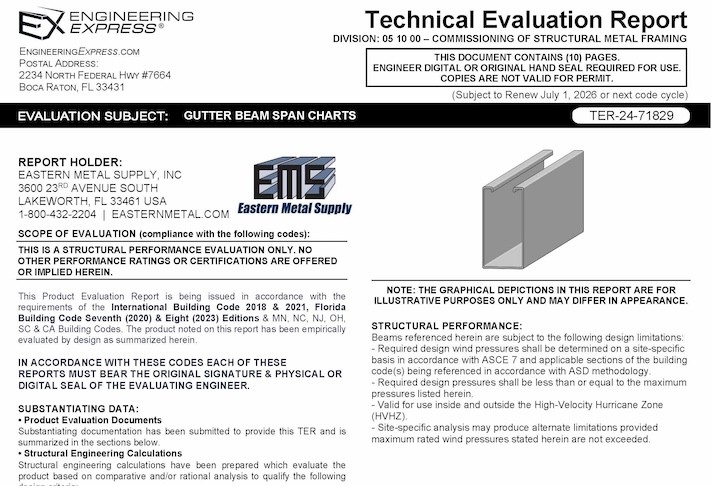What's A TER?
A TER, or Technical Evaluation Report, are engineer-certified, code-compliant evaluation of a building products performance limitations.
They provide limiting capacities for wind, snow, seismic, and other forces for a variety of product sizes and installation conditions.
TER for a gutter beam for Eastern Metal Supply.
What Doesn't A TER Do?
- TER's don't certify an installation at a site-specific address
- TER's don't list the full fabrication & assembly instructions of a building product
- TER's Don't Certify An Installation At A Site-Specific Address
- TER's Don't have an agency approval such as an ICC or Miami Dade NOA - So an original Sealed Copy Is Required.
- TER's typically don't certify electrical, water (gutters, plumbing), or HVAC requirements - they are structural only
A Practical Example
Think of a TER as the approval rating for a ladder, like ‘300lb limit’.
No matter where that ladder goes on earth it is subject to break above 300lb (with a reasonable safety factor).
The ladder rating doesn’t state the names of people or types of industries it’s approved for, that’s up to the end-user.
This is just like these evaluation reports which state a wind pressure performance limit and not the cities, houses, or types of structures they can be used with
TER's Do Help Quite A Bit Though, And So Do We
Learn more about Technical Evaluation Reports from this article, or browse the below.
They are a necessary part in obtaining a building permit and proper, safe construction.
Let us help create an Evaluation Report for your building product or help create site-specific documents for your project.
For guidance with your next project, explore our Plans, Calculators, Knowledge Base,
or contact us directly for site-specific support
Last Update: October 30, 2025
Related Knowledge Base Posts -
- Should a professional utilize the ASD (Allowable Stress Design) method or the LRFD (Load Resistance Factored Design) method when calculating the required wind pressure for use with tested-approved systems?
- Did the wind loading requirements change for rooftop structures for ASCE 7-22 – ASCE 7-16 & The Florida Building Code?
- ASCE 7 WIND EXPOSURE CATEGORIES AND HOW EXPOSURE ‘D’ WORKS
- What are the requirements for using ASTM Missile Level E in Florida and the US?
- What wind information is required for construction documents?
- How do I calculate the effective opening area on window or door products? – What opening area should be used for wind pressure determination on a multi-panel product?
